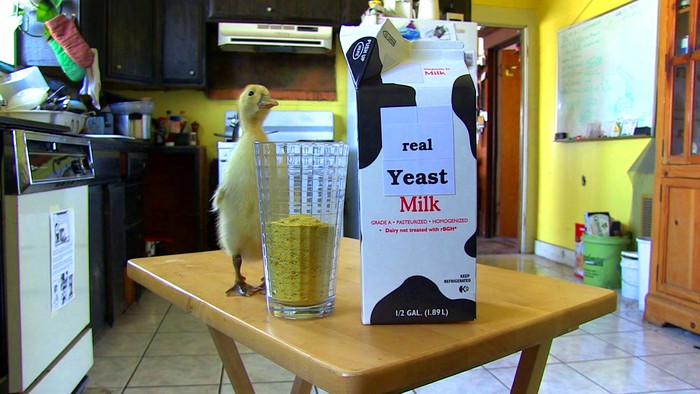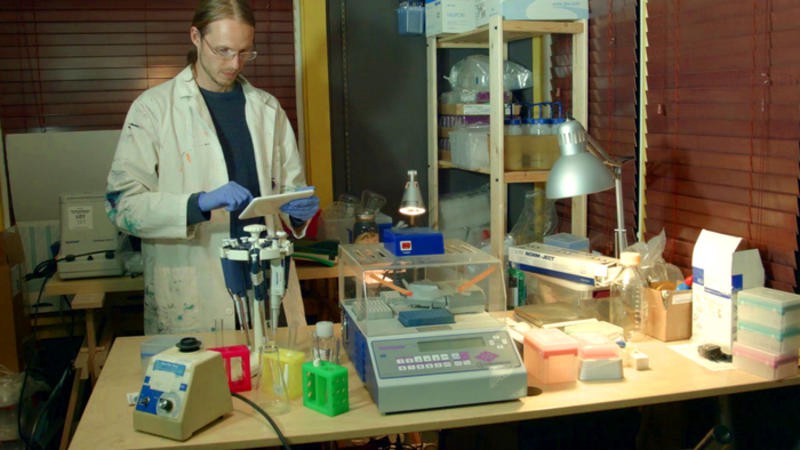

Craig Rouskey is a self-identified pragmatist. But that’s not stopping him from trying to overturn a human craft that’s existed for over 5,000 years–making cheese from animal’s milk. On Sunday, Rouskey and over two dozen DIY biologists finished their crowdfunding campaign to synthetically engineer baker’s yeast (as in, the stuff that makes your bread) and then churn out proteins typically found in cow’s milk.
In keeping with his pragmatic ethos, it’s all in pursuit of a good cause. Dubbed “Real Vegan Cheese,” the product would not only be animal-free, but do away with the agriculture required for nut-based vegan cheeses currently on the market. If it works, it’ll be as close to zero-impact as you can get. As the environmental impact of food and world hunger become ever-pressing concerns, Rouskey sees this as the practical solution. “Here is this environmental issue around dairy production, and there’s now an opportunity to produce cheese in a synthetic way that eliminates that,” Rouskey said. “We’re trying to do that.”

All of the science will be done out of two DIY lab spaces in the San Francisco Bay Area: Counter Culture Labs in Oakland and BioCurious in Sunnyvale. Rouskey and his motley crew of fellow biohackers will first take the genes for cow milk proteins called caseins and synthesize them from scratch. After making a large number of gene copies, they’ll stick them into the yeast genome along with another set of directions that will cause the yeast to secrete the proteins out of the cell. The growing yeast will then churn out the milk proteins, which Rouskey will purify out and mix with a vegan milk-fat replacement, some sugar and water to create vegan milk. Then, Rouskey said, the cheese-making will proceed as usual.
Beyond the estimated 65 percent of adults who can’t digest lactose in the first place, and those who avoid animal products on moral grounds, more evidence is building that our growing reliance on meat and dairy products is bad for the environment. According to a study published last week, the efficiency of livestock converting plant feed to meat is less than three percent, which means that as our appetites for meat and dairy continue to increase, so do demands on agriculture. Researchers estimate that the resulting increases in deforestation, fertilizer use and methane emissions (caused by cattle’s well known propensity for burping) will cause greenhouse gases from food production to increase by 80 percent by the year 2050.
Real Vegan Cheese’s yeast, in contrast, promises to be a constant, low-emission food source. Rouskey said, “As long as they’re growing, you have the proteins to make cheese. We’re not harvesting nuts or raising cows; it’s a closed system.” With nearly 700 backers contributing $37,369 in funds (over twice the funding goal), a cohort of environmentally conscious cheese fans seem to be behind the product. But can yeast factories spewing out cow proteins really make something that, at the end of the day, tastes as good as gouda? The answer, Rouskey said, is uncertain. Without lactose, it’s unclear whether their Real Vegan Cheese will be able to support the same strains of bacteria responsible for the pungent flavors in the hundreds of strains of cheeses made around the world. But, to Rouskey, it’s more than worth a shot.
“We’re just getting to a time and place in human culture where we’re realizing that food scarcity is going to be a huge issue. We have to branch out and innovate with how we make our food, and most importantly, we need to use technology in a transparent way,” he said.
Rouskey also hopes that this transparency will make people more eager to accept the usefulness of biotech in food production, helping to undo some of the bad flack its gotten as a result of practices by corporations like Monsanto. Part of that is being clear about what is and isn’t genetically modified. Rouskey’s group clearly states that all of the genetically modified yeast will be purified out of its finished protein sample. But another big part is that the collective has agreed to keep its final product totally open source. With dreams of vegan cheese-making DIY bio lab spaces in rural Africa, Rouskey’s optimism may be outpacing his pragmatism. But, he said, “If it’s not doing some good, I don’t really need to be involved with it.”


How We Get To Next was a magazine that explored the future of science, technology, and culture from 2014 to 2019. This article is part of our The Future of Food section, which covers new innovations changing everything from farming to cooking. Click the logo to read more.
